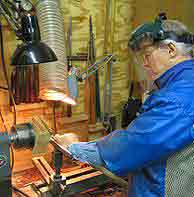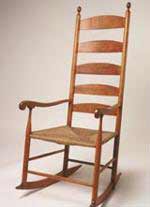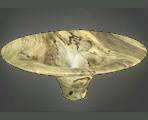VOICE ONE:
I'm Steve Ember.
VOICE TWO:

And I'm Shirley Griffith with EXPLORATIONS in VOA Special English. At several galleries in the Washington, D.C. area, you might see work by the wood turner Phil Brown. His many wooden bowls and containers have a smooth and modern look.
One tall bowl with a wide opening is made from black cherry wood. It is so perfectly formed it is hard to believe it is handmade. How did Phil Brown make this bowl? We will answer this question as we explore the many artistic traditions of wood.
(MUSIC)
VOICE ONE:
People from almost all cultures throughout history have been making objects from wood. Some of the first wooden objects included weapons and tools. Early cultures also learned to make boats, buildings and furniture for the home from this material. However, it is not always easy to say which wooden objects existed during a historical period because they often did not last as long as objects made from clay or metal.
VOICE TWO:
Experts say most current woodworking tools were developed by the beginning of the Bronze Age, about 5000 years ago. These tools include the saw, axe, chisel and drill which are used to cut and shape wood in different ways. The lathe may have been developed as early as 2700 years ago.
This tool holds and rotates the wood. As the wood turns, the wood worker uses a sharp tool to slowly and evenly cut pieces from the wood.
VOICE ONE:
There are many methods of woodworking and each culture has its own traditions. Artistic wood creations include architectural decoration on buildings, furniture for the home or even carved animals.
For example, in Thailand, richly detailed carvings from teak and other hard woods are an important part of ancient palaces and religious buildings. Woodcarvers were a very important group of artists. A person needed many years of training with experts to be a wood carver. Wood carvings often include plant forms such as the lotus flower as well as figures taken from Hindu and Buddhist religious stories.
VOICE TWO:
The carvings are very detailed and must be carefully planned. Usually, a carver draws out the patterns and forms on paper. Then the artist cuts holes along the outlines of the design. This paper is placed on the piece of wood then covered with chalk dust.
The white chalk dust goes through the holes in the paper and marks the wood so the carver has a visual guide to begin cutting. Finished woodcarvings are often painted, sometimes with gold to reflect the surrounding light. These expertly made golden carvings give an airy lightness to Thai buildings.
(MUSIC)
VOICE ONE:

Some wood working traditions developed more recently. For example, wood artists in the state of Oaxaca in Mexico have been carving mask face coverings and toys for hundreds of years. But Manuel Jimenez became one of the most famous carvers in Oaxaca by creating a newer tradition.
In the 1950s, he saw a growing demand for traditional Mexican art that visitors wanted to buy. He decided to experiment with new kinds of wood and forms. He started carving expressive animals such as frogs, coyotes and rabbits out of copal wood.
Soon, his whole family started helping produce these lively, wooden creatures. The Jimenez men carved the creations while the women painted them with bright colors and patterns. Other wood carvers in the area also started making their own kinds of animals. Now, Oaxaca is famous for this special kind of wood art.
VOICE TWO:
Colorful paints are not the only way to finish a wood object. In countries like Japan and China there is a rich tradition of painting wooden bowls, boxes and other objects with lacquer. The first kinds of lacquer were made from resin material taken from special trees. Lacquer paint creates a very hard and smooth surface over the wood and protects it from water. Japanese and Chinese lacquer work is often red or black. Sometimes it can be decorated with pieces of silver or gold metal to create an image.
VOICE ONE:
And, sometimes wood can even decorate wood. Inlay is a way of decorating wood with a pattern or image made out of small pieces of wood. The many small pieces of wood can have different colors or patterns. Some inlay experts in 17th century France and Spain added valuable materials like shiny mother-of-pearl or tortoise shell to the detailed wood inlay.
VOICE TWO:

In the United States, the Shaker tradition of furniture making is known for its simplicity of form. The Shakers were a religious community that came to the United States in the 18th century from England. They practiced an intense form of spiritual observance and believed strongly in the value of hard work and keeping busy.
The Shakers developed their own style of furniture. They designed it very carefully with the idea that making something well was an act of prayer. They made furniture that was as simple and useful as possible because they believed extra details and designs were unnecessary and wrong. But their furniture in its total simplicity became famous for its beauty. Chairs to sit on are probably the most well known Shaker furniture. The very fine and thin wood pieces give these chairs a clean and graceful look.
(MUSIC)
VOICE ONE:
Phil Brown is an American artist who creates art with wood in a different way. He lives on a quiet street in Bethesda, Maryland, near Washington, D.C. In his workshop, he turns large pieces of wood into fine containers. Let us meet this expert wood turner whose bowls we talked about earlier and learn how he started his career.
PHIL BROWN: "I'm Phil Brown. I'm a wood turner. I make bowls out of solid wood. The wood comes from our local trees and I have a shop at my home where I do the work. I've been a wood worker ever since I was a kid. And in the early seventies I wanted to get back to doing some wood work and we saw lots of interesting work in Maine on some trips there and I had a chance to get some apple wood from a friend ...what are you going to do with apple wood but maybe turn a bowl out of it. So I bought a used lathe and a book about turning and gradually taught myself to turn a bowl."
VOICE TWO:

In the living room of his home Phil Brown has a special area where he shows his finished art. There are bowls of all shapes and sizes. Some are deep and large with reddish brown colored wood. Others are small with yellowish wood that has dark lines and shapes. Mr. Brown can explain exactly where and when he found each tree that he used to make a bowl. And he can show you what all the lines and rings in the wood represent. They are like maps of the tree's life. Some lines are caused by fungus organisms while others show the area where a branch of the tree trunk used to be. But to really understand Mr. Brown's wood turning art, you have to visit his workshop downstairs.
VOICE ONE:
The workshop is filled with many tools and machine parts. On one wall there are shelves filled with roughly cut wooden bowls that are drying out. Allowing the wood to dry helps guarantee that it will not change shape later on. Before "turning the bowl thin" Mr. Brown puts a layer of epoxy paint material over the roughly cut bowl. This hardens areas of the wood that might be softer or contain fungus. Then, Mr. Brown places the bowl on his lathe.
(SOUND)
VOICE TWO:

The lathe turns the wood quickly. Using a long metal tool called a gouge, Mr. Brown slowly cuts away at the wooden form. With great skill he slowly keeps cutting away until the bowl has the right thinness and form. Then, Mr. Brown uses rough sandpaper to smooth the gouge marks in the wood. As the wood becomes smoother, he uses finer and finer kinds of sandpaper. He sometimes fills any holes or cracks with a mixture of epoxy glue, sanding dust, and brown paint. Finished bowls are so smooth and perfect they do not even feel like wood.
VOICE ONE:
Phil Brown shows his beautiful bowls at several fine craft stores and in art shows. He even has a bowl at the Renwick Gallery of the Smithsonian American Art Museum in Washington, D.C. Sometimes he sells works directly from his workshop. His turned wood bowls cost hundreds of dollars. Many people have collections of his bowls in their homes.
Mr. Brown says he is influenced by the work of sculptors like Henry Moore and Isamu Noguchi. He says he likes to make bowls that have smooth surfaces and that bring out the natural color of wood. His finely made art is a celebration of the life of a tree and the endless possibilities of wood.
(MUSIC)
VOICE TWO:
This program was written and produced by Dana Demange. I'm Shirley Griffith.
VOICE ONE:
And I'm Steve Ember. You can read and listen to this program on our Web site, voaspecialenglish.com. Join us again next week for Explorations in VOA Special English.
lathe: a machine for shaping a piece of material, such as wood or metal, by rotating it rapidly along its axis while pressing a fixed cutting or abrading tool against it 车床
teak: a tall evergreen tree (Tectona grandis) of southeast Asia, having hard, heavy, durable yellowish-brown wood 柚木
coyote: a small wolflike carnivorous animal (Canis latrans) native to western North America and found in many other regions of the continent (北美大草原的)郊狼,土狼
copal: any of several brittle aromatic yellow to red resins of recent or fossil origin, obtained from various tropical trees and used in certain varnishes 天然树脂
resin: any of a group of solid or semisolid amorphous compounds that are obtained directly from certain plants as exudations. They are used in medicine and in varnishes 树脂
epoxy: any of various usually thermosetting resins capable of forming tight cross-linked polymer structures characterized by toughness, strong adhesion, and low shrinkage, used especially in surface coatings and adhesives 环氧树脂
Related stories:
Exploring the magical world of puppets
Exploring the history and art of printmaking
Exploring the art of glass through history and around the world
From clay to art: exploring the world of ceramics
(Source: VOA 英语点津编辑)